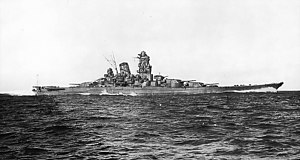
Back Yamato-klas slagskip Afrikaans Clase Yamato AST Линейни кораби тип „Ямато“ Bulgarian Třída Jamato Czech Yamato-Klasse German Κλάση θωρηκτών Γιαμάτο Greek Clase Yamato Spanish نبردناو کلاس یاماتو Persian Yamato-luokka Finnish Classe Yamato French
 Yamato undergoing trials in 1941
| |
| Class overview | |
|---|---|
| Name | Yamato class |
| Builders | |
| Operators | |
| Preceded by |
|
| Succeeded by | A-150 class (planned) |
| Subclasses | 2 (Shinano- and No. 797-class) |
| Cost | ¥250,000,897 (equivalent to about ¥132,000,000,000 in 2019)[1] |
| Built | 1937–1942 |
| In commission | 1941–1945 |
| Planned | 5 |
| Completed | 3 (2 battleships, 1 converted to aircraft carrier) |
| Cancelled | 2 (one subclass) |
| Lost | 3 |
| General characteristics (as built) | |
| Type | Battleship |
| Displacement | |
| Length | |
| Beam | 38.9 m (127 ft 7 in)[2] |
| Draught | 10.4 m (34 ft) |
| Installed power |
|
| Propulsion | 4 shafts; 4 steam turbines |
| Speed | 27 knots (50 km/h; 31 mph)[2] |
| Range | 7,200 nmi (13,300 km; 8,300 mi) at 16 knots (30 km/h; 18 mph)[2] |
| Complement | 2,767[4] |
| Armament |
|
| Armor | |
| Aircraft carried |
|
The Yamato-class battleships (大和型戦艦, Yamato-gata senkan) were two battleships of the Imperial Japanese Navy, Yamato and Musashi, laid down leading up to World War II and completed as designed. A third hull, laid down in 1940, was converted to an aircraft carrier, Shinano, during construction.
Displacing nearly 72,000 long tons (73,000 t) at full load, the completed battleships were the heaviest ever constructed in the world. The class carried the largest naval artillery ever fitted to a warship, nine 460 mm (18.1 in) naval guns, each capable of firing 1,460 kg (3,220 lb) shells over 42 km (26 mi).
Due to the threat of U.S. submarines and aircraft carriers, both Yamato and Musashi spent the majority of their careers in naval bases at Brunei, Truk, and Kure—deploying on several occasions in response to U.S. raids on Japanese bases.
All three ships were sunk by the U.S. Navy; Musashi sank by air strikes while participating in the Battle of Leyte Gulf in October 1944, Shinano sank after being torpedoed by the submarine USS Archerfish while under way from Yokosuka to Kure for fitting out in November 1944, and Yamato sank by air strikes while en route from Japan to Okinawa as part of Operation Ten-Go in April 1945.
- ^ Kwiatkowska, K. B.; Skwiot, M. Z. "Geneza budowy japońskich pancerników typu Yamato". Morza Statki I Okręty (in Polish). 2006 (1). Warsaw: Magnum-X: 74–81. ISSN 1426-529X. OCLC 68738127.
- ^ a b c d e f Jackson, p. 74; Jentschura et al., p. 38
- ^ a b c d e Cite error: The named reference
jackson74was invoked but never defined (see the help page). - ^ Cite error: The named reference
Schom, p. 270was invoked but never defined (see the help page). - ^ a b c d Hackett, Robert; Kingsepp, Sander; Ahlberg, Lars. "Yamato-class Battleship". Combined Fleet. CombinedFleet.com. Archived from the original on 16 October 2008. Retrieved 25 October 2008.
© MMXXIII Rich X Search. We shall prevail. All rights reserved. Rich X Search